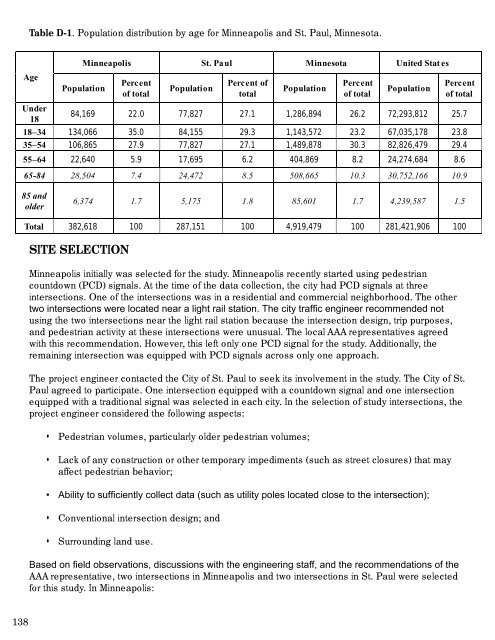Pedestrian Signal Safety - AAA Foundation for Traffic Safety
Pedestrian Signal Safety - AAA Foundation for Traffic Safety
Pedestrian Signal Safety - AAA Foundation for Traffic Safety
You also want an ePaper? Increase the reach of your titles
YUMPU automatically turns print PDFs into web optimized ePapers that Google loves.
138<br />
Table D-1. Population distribution by age <strong>for</strong> Minneapolis and St. Paul, Minnesota.<br />
Age<br />
Under<br />
18<br />
Minneapolis St. Paul Minnesota United Stat es<br />
Population<br />
Percent<br />
of total<br />
Population<br />
Percent of<br />
total<br />
Population<br />
Percent<br />
of total<br />
Population<br />
Percent<br />
of total<br />
84,169 22.0 77,827 27.1 1,286,894 26.2 72,293,812 25.7<br />
18–34 134,066 35.0 84,155 29.3 1,143,572 23.2 67,035,178 23.8<br />
35–54 106,865 27.9 77,827 27.1 1,489,878 30.3 82,826,479 29.4<br />
55–64 22,640 5.9 17,695 6.2 404,869 8.2 24,274,684 8.6<br />
65-84 28,504 7.4 24,472 8.5 508,665 10.3 30,752,166 10.9<br />
85 and<br />
older<br />
6,374 1.7 5,175 1.8 85,601 1.7 4,239,587 1.5<br />
Total 382,618 100 287,151 100 4,919,479 100 281,421,906 100<br />
SITE SELECTION<br />
Minneapolis initially was selected <strong>for</strong> the study. Minneapolis recently started using pedestrian<br />
countdown (PCD) signals. At the time of the data collection, the city had PCD signals at three<br />
intersections. One of the intersections was in a residential and commercial neighborhood. The other<br />
two intersections were located near a light rail station. The city traffic engineer recommended not<br />
using the two intersections near the light rail station because the intersection design, trip purposes,<br />
and pedestrian activity at these intersections were unusual. The local <strong>AAA</strong> representatives agreed<br />
with this recommendation. However, this left only one PCD signal <strong>for</strong> the study. Additionally, the<br />
remaining intersection was equipped with PCD signals across only one approach.<br />
The project engineer contacted the City of St. Paul to seek its involvement in the study. The City of St.<br />
Paul agreed to participate. One intersection equipped with a countdown signal and one intersection<br />
equipped with a traditional signal was selected in each city. In the selection of study intersections, the<br />
project engineer considered the following aspects:<br />
• <strong>Pedestrian</strong> volumes, particularly older pedestrian volumes;<br />
• Lack of any construction or other temporary impediments (such as street closures) that may<br />
affect pedestrian behavior;<br />
• Ability to sufficiently collect data (such as utility poles located close to the intersection);<br />
• Conventional intersection design; and<br />
• Surrounding land use.<br />
Based on field observations, discussions with the engineering staff, and the recommendations of the<br />
<strong>AAA</strong> representative, two intersections in Minneapolis and two intersections in St. Paul were selected<br />
<strong>for</strong> this study. In Minneapolis:








